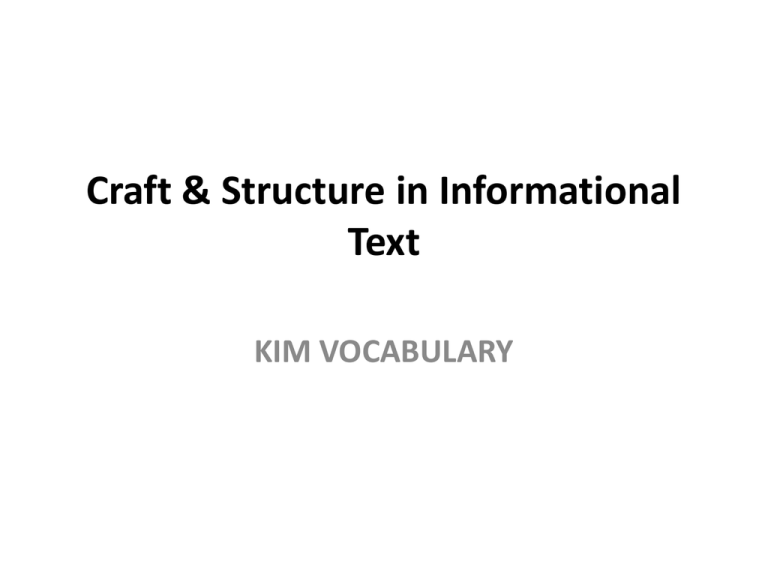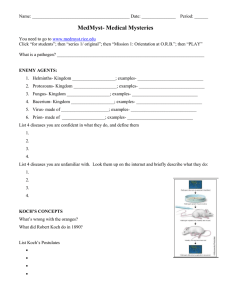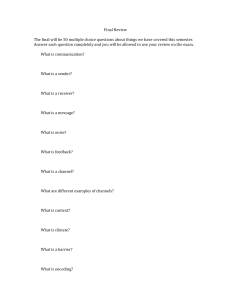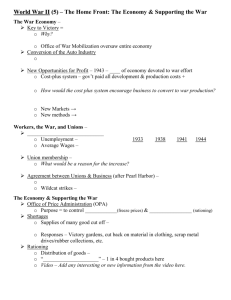KIM Vocabulary with Key Words
advertisement

Craft & Structure in Informational Text KIM VOCABULARY Figurative Meaning • Meanings that are not literal associated with the image the text creates in a readers mind. • Example: The lake is a treasure chestmetaphor • Means- It is a wonderful find. Simile • Makes a comparison using like or as. Example: He runs as fast as a tiger. Metaphor • Makes a comparison without using like or as Example: He is a tiger when he runs. Connotative Meaning • How the word is used in • Example-The context, often refers to determined scientist how it makes the reader searched in the lake. feel. • Determined here is being used positively and may mean worthy of respect. Technical Meanings • Words used in a specific subject area. • Example-Vocabulary Words in Science • Subglacial • Meaning-beneath a glacier, or a huge mass of ice Author’s Purpose • The reason an author gives for writing something. In informational writing, the author writes to provide facts and details about a topic. • • • • • Examples: To inform To entertain To persuade To describe Informational Text • Text whose purpose is to inform or educate the reader. Will contain facts. • Examples: Feature Articles, Newspapers, Time Magazine Persuasive Writing • An author writes to try to convince the reader of something. • Editorials Opinion • A view or judgment formed about something, not necessarily based on fact or knowledge. Example: I think that all students should always try hard. Point of View • may include opinions that indicate the author’s point of view on the topic. Sometimes writer’s contrast their opinions with those of others to help make a point. • 1st Person- I perspective • 2nd Person- “You” • 3rd- He or She • Point of view will prove something in informational writingScuba diving has many benefits. Perspective • Also known as the point of view- it is the stance that the writer takes in their writing. It could also be called how they see it. Word Choice • The words the author selects to use that establishes the tone of the passage. • If my tone is admiring, I might use words or phrases like “beautiful” or “kind and gentle”. Tone • The author’s voice or attitude about what he or she writes. • Example- happy, sad, annoyed, anxious, etc. Text Structure • The way the text is organized. • Cause and effect • Sequence • Chronological Organizational patterns • Another term for text structures- refers to how the text is organized on the page. • Comparison/Contrast • Description Cause & Effect • Type of text structure that describes a reason and its effect(s) • Examples- Signal words such as effect, as a result, because, for this reason Comparison/ Contrast • Type of text structure that compares and contrasts specific elements of two or more things. • Examples- Signal words alike, as opposed to, different, in common, on the other hand, similar Description • Type of text structure that describes a topic with descriptive details. • Examples- Signal words above, across, behind, beside, between, far, in front of, near, over, under Problem/Solution • Type of text structure that describes a problem and its solution. • Examples- Signal words affect, as a result, because, consequently, for this reason, if…then, since, therefore Sequence/ Process • Type of text structure that explains how to do or make something in a specific order. • Examples- Signal words after, before, finally, first, last, later, next, then Heading • This is the title of nonfiction articles. • Article heading might be- Tips for Healthy Living Caption • Text found under a picture with a description. This picture shows a diagram of the food Pyramid. This should guide you in your daily food Intake. Subheading • These are the bold words found between sections in an article that highlights the topic. These are used to organize text. • Example in the article Tips for Healthy Living a subheading may be Drink Plenty of Water Bias • A bias is a subjective point of view (either positive or negative). Sally’s handwriting is so neat. She must be very smart. She deserves all A’s on her report card. Tommy’s handwriting is terrible. He must not be real smart. He deserves at least one D on his report card. Stereotypes • A stereotype is a generalization about a group of people. All blondes are dumb. • Biases can lead to stereotypes. All students with neat handwriting are smart. All students with poor handwriting are not smart. Girls have better handwriting than boys. Girls are smarter than boys. Propaganda • Propaganda is the • Advertisements spreading of ideas in a way to force ideas onto others. Propaganda may include facts but not all of them. Propaganda usually distorts (slants) the facts. Propaganda can be misleading and dangerous. Bandwagon • Uses the idea that everyone is doing something, and if you don’t, you’ll be left out Everyone uses social media! Faulty Cause and Effect • slants facts to make it • As an example of how logic seem one event causes can be abused, consider the another event following argument: • Premise 1: Joe Smith supports gun-control legislation. • Premise 2: All fascist organizations have passed gun-control legislation. • Conclusion: Therefore, Joe Smith is a fascist. Emotional Words • uses words that appeal to people’s feelings • Feed the Children commercials or Support the Humane Society Expert Opinion • uses a knowledgeable person to convince others • Examples: dermatologists, dentists, doctors Testimonial • uses the name of a famous person to persuade • Justin Bieber uses proactive to get clear skin, you should too! Repetition • repeats important information over and over • Example: Head On! Apply directly to the forehead. Head On! Apply directly to the forehead. Head On! Apply directly to the forehead. Name Calling • uses belittling words to show negative feelings toward something or someone • McDonalds vs. Burger King Statistics • Use of facts that involve numbers • Nine out of 10 dentists recommend Colgate! Appeal to Authority • Appeals to authority cite prominent figures to support a position, idea, argument, or course of action. • Because _______ said this it must be true.






